Tsoulfanidis N. Measurement and detection of radiation
Подождите немного. Документ загружается.

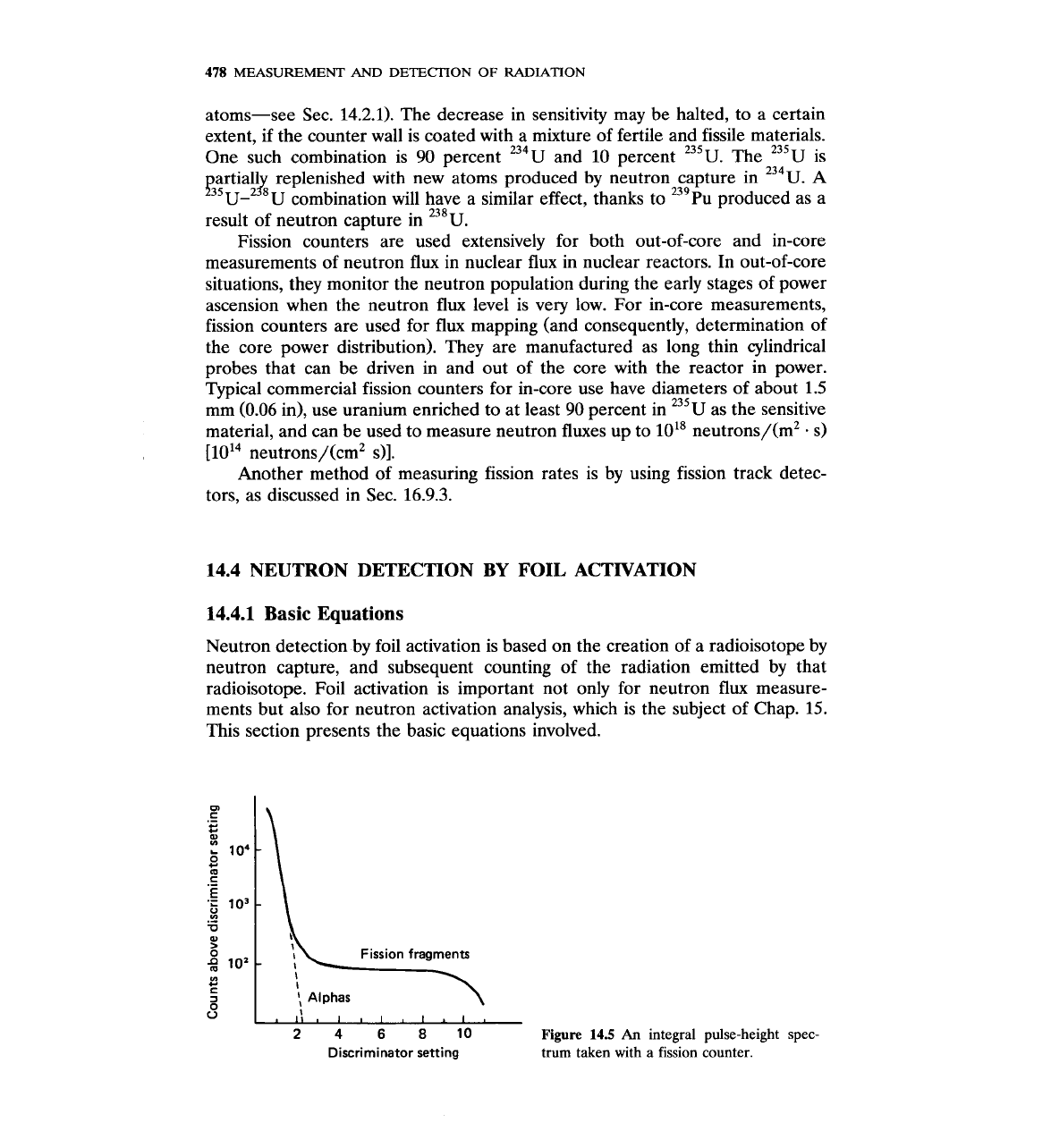
478
MEASUREMENT
AND
DETECTION
OF
RADIATION
atoms-see Sec. 14.2.1). The decrease in sensitivity may be halted, to a certain
extent, if the counter wall is coated with a mixture of fertile and fissile materials.
One such combination is 90 percent
234~
and 10 percent 235~. The
235~
is
artiall replenished with new atoms produced by neutron capture in
234~.
A
%5
23x
U-
U combination will have a similar effect, thanks to
239~~
produced as a
result of neutron capture in
238~.
Fission counters are used extensively for both out-of-core and in-core
measurements of neutron flux in nuclear flux in nuclear reactors. In out-of-core
situations, they monitor the neutron population during the early stages of power
ascension when the neutron flux level is very low. For in-core measurements,
fission counters are used for flux mapping (and consequently, determination of
the core power distribution). They are manufactured as long thin cylindrical
probes that can be driven in and out of the core with the reactor in power.
Typical commercial fission counters for in-core use have diameters of about 1.5
mm (0.06 in), use uranium enriched to at least 90 percent in
235~
as the sensitive
material, and can be used to measure neutron fluxes up to 1018 neutrons/(m2
.
s)
[1014 neutrons/(cm2
dl.
Another method of measuring fission rates is by using fission track detec-
tors, as discussed in Sec. 16.9.3.
14.4
NEUTRON DETECTION
BY
FOIL ACTIVATION
14.4.1
Basic Equations
Neutron detection by foil activation is based on the creation of a radioisotope by
neutron capture, and subsequent counting of the radiation emitted by that
radioisotope. Foil activation is important not only for neutron flux measure-
ments but also for neutron activation analysis, which is the subject of Chap. 15.
This section presents the basic equations involved.
Fission fragments
:\
\
246810
Figure
14.5
An
integral pulse-height spec-
Discriminator setting
trum taken with
a
fission counter.
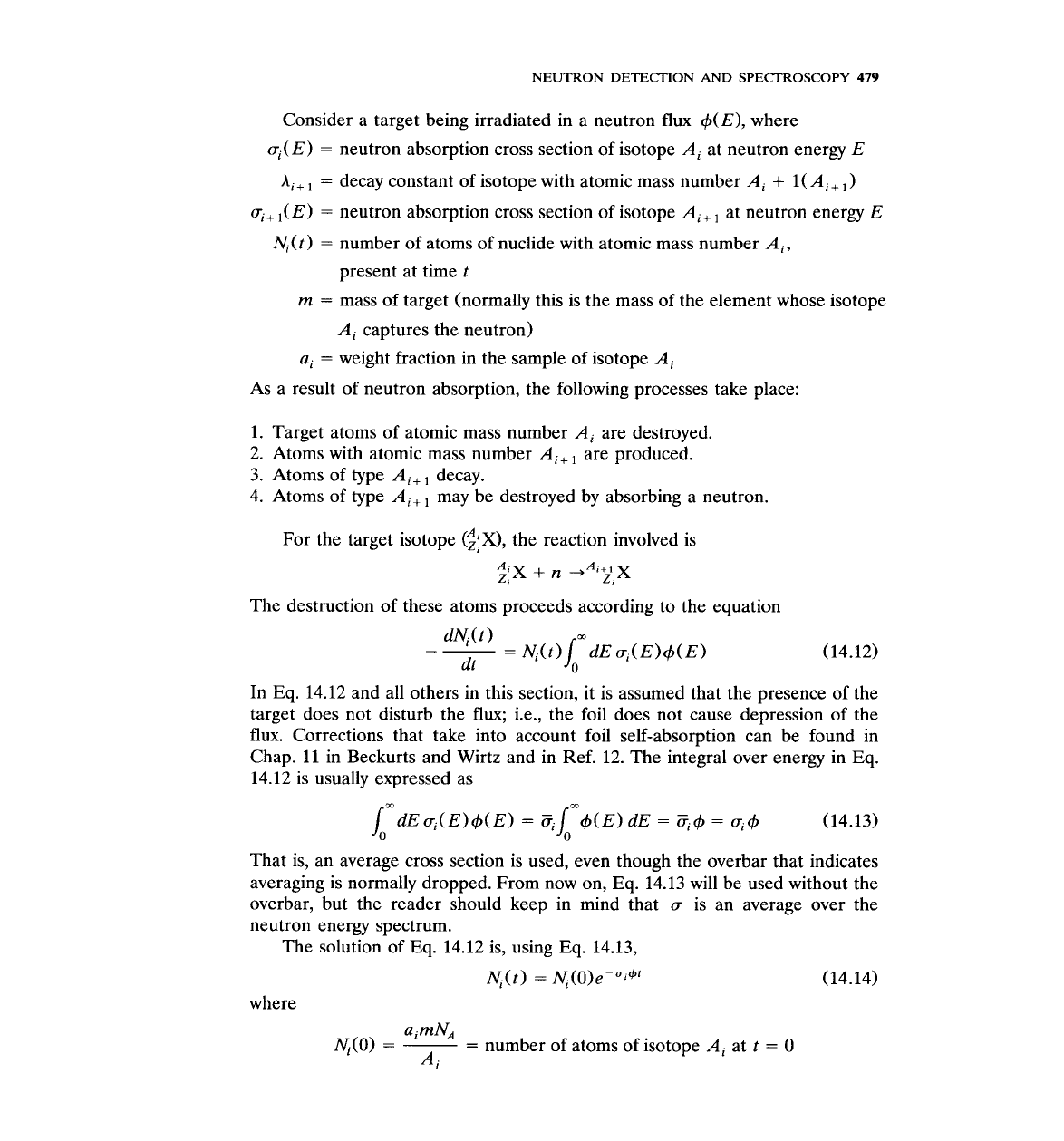
NEUTRON
DETECTION
AND
SPECTROSCOPY
479
Consider a target being irradiated in a neutron
flux
+(E), where
ui(
E)
=
neutron absorption cross section of isotope
A,
at neutron energy
E
A,,
,
=
decay constant of isotope with atomic mass number
Ai
+
1(
A,,
u,,
,(El
=
neutron absorption cross section of isotope
A,,
,
at neutron energy
E
N,
(t
)
=
number of atoms of nuclide with atomic mass number
A,,
present at time
t
rn
=
mass of target (normally this is the mass of the element whose isotope
A,
captures the neutron)
a,
=
weight fraction in the sample of isotope
A,
As a result of neutron absorption, the following processes take place:
1. Target atoms of atomic mass number
A,
are destroyed.
2. Atoms with atomic mass number
A,,
,
are produced.
3. Atoms of type
A,,
,
decay.
4. Atoms of type
A,,,
may be destroyed by absorbing a neutron.
For the target isotope
($:x),
the reaction involved is
2:~
+
n
z,
X
The destruction of these atoms proceeds according to the equation
In Eq. 14.12 and all others in this section, it is assumed that the presence of the
target does not disturb the
flux;
i.e., the foil does not cause depression of the
flux.
Corrections that take into account foil self-absorption can be found in
Chap. 11 in Beckurts and Wirtz and in Ref. 12. The integral over energy in Eq.
14.12 is usually expressed as
That is, an average cross section is used, even though the overbar that indicates
averaging is normally dropped. From now on, Eq. 14.13 will be used without the
overbar, but the reader should keep in mind that
u
is an average over the
neutron energy spectrum.
The solution of
Eq.
14.12 is, using Eq. 14.13,
N,(t)
=
N,(0)ep"~4' (14.14)
where
airnNA
Ago)
=
-
-
-
number of atoms of isotope
Ai
at
t
=
0
A
i
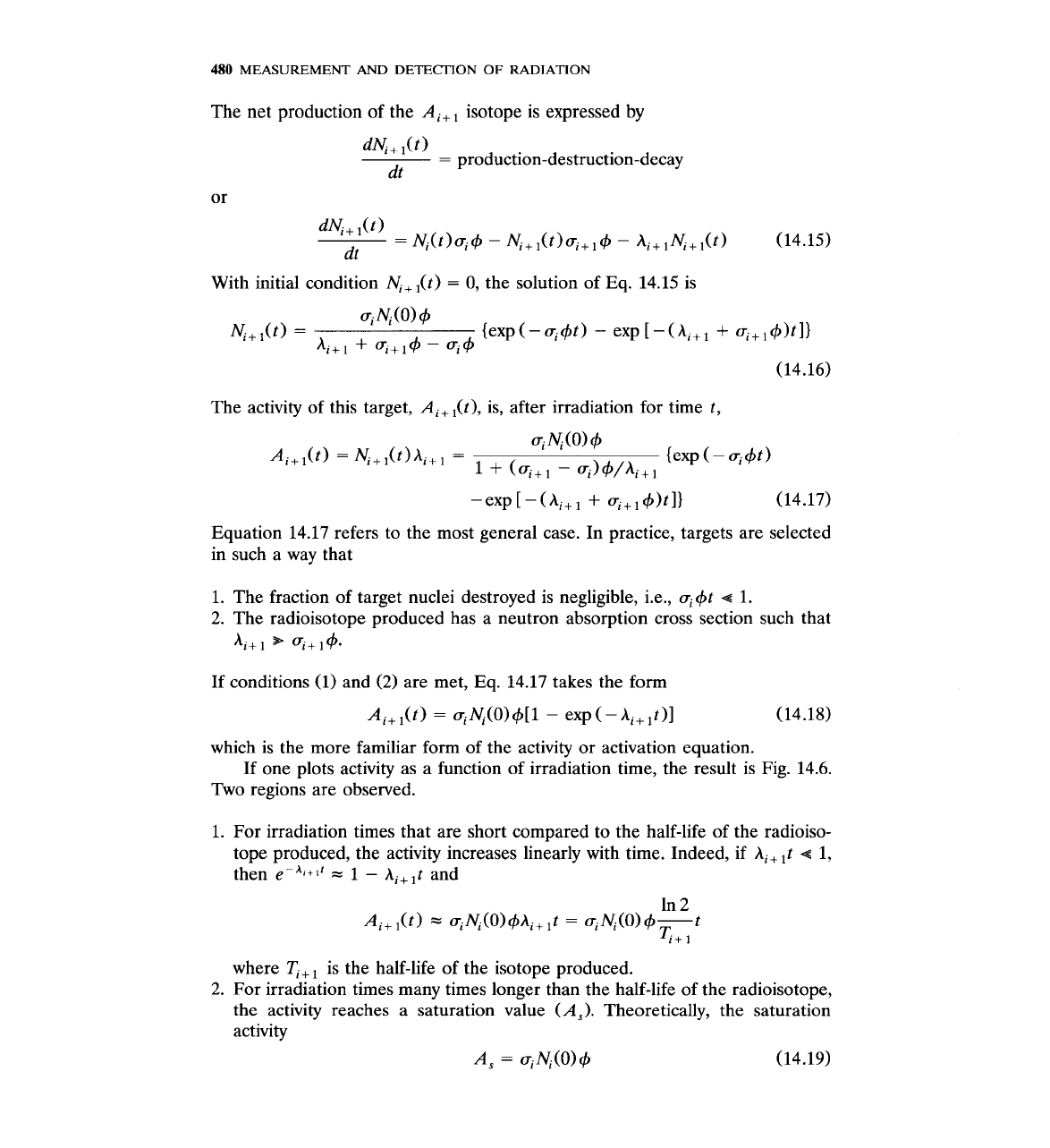
480
MEASUREMENT
AND DETECTION
OF
RADIATION
The net production of the A,+
,
isotope is expressed by
dN,+
,(t)
=
production-destruction-decay
dt
With initial condition
N,.+
,(t)
=
0, the solution of Eq. 14.15 is
The activity of this target, A,+ ,(t), is, after irradiation for time t,
-exp[-(Ai+,
+
ui+,+)tll (14.17)
Equation 14.17 refers to the most general case. In practice, targets are selected
in such a way that
1.
The fraction of target nuclei destroyed is negligible, i.e., ui+t
4
1.
2.
The radioisotope produced has a neutron absorption cross section such that
hi+,
mi+,+.
If conditions (1) and
(2)
are met, Eq. 14.17 takes the form
A,+ ,(t)
=
ui4(0)+[l
-
exp (-Ai+,t)l
(14.18)
which is the more familiar form of the activity or activation equation.
If one plots activity as a function of irradiation time, the result is Fig. 14.6.
Two regions are observed.
1. For irradiation times that are short compared to the half-life of the radioiso-
tope produced, the activity increases linearly with time. Indeed, if
A,+
,t
4
1,
then
e-"+I'
.=
1
-
A,+,t
and
where
T,+
,
is the half-life of the isotope produced.
2.
For irradiation times many times longer than the half-life of the radioisotope,
the activity reaches a saturation value (A,). Theoretically, the saturation
activity
A,
=
u,&(O)+ (14.19)
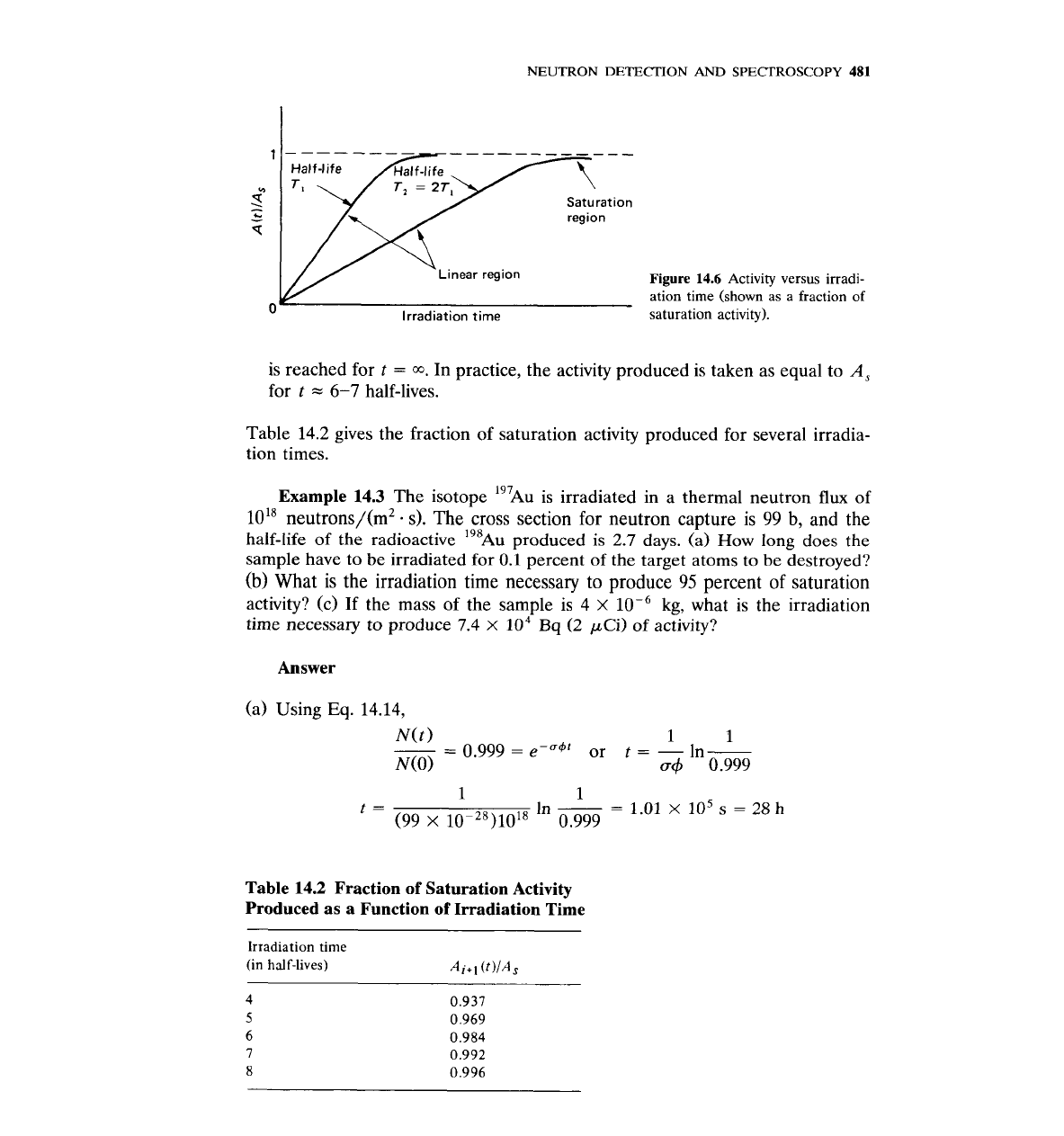
NEUTRON
DETECTION
AND
SPECTROSCOPY
481
Saturation
Figure
14.6
Activity versus irradi-
ation time (shown as a fraction of
Irradiation time saturation activity).
is reached for t
=
m.
In practice, the activity produced is taken as equal to
A,
for
t
=
6-7
half-lives.
Table 14.2 gives the fraction of saturation activity produced for several irradia-
tion times.
197
Example
14.3
The isotope
Au is irradiated in a thermal neutron
flux
of
1018
neutrons/(m2. s). The cross section for neutron capture is 99
b,
and the
half-life of the radioactive I9'~u produced is
2.7
days. (a)
How
long does the
sample have to be irradiated for 0.1 percent of the target atoms to be destroyed?
(b)
What is the irradiation time necessary to produce
95
percent of saturation
activity? (c) If the mass of the sample
is
4
X
lop6
kg, what is the irradiation
time necessary to produce
7.4
x
lo4
Bq
(2
pCi) of activity?
Answer
(a) Using
Eq.
14.14,
N(t)
--
1
1
N(0)
-
0.999
=
epU4' or
t
=
-
ln-
0.999
Table
14.2
Fraction of Saturation Activity
Produced
as
a Function of Irradiation Time
Irradiation time
(in
half-lives) A;+, (t)/A,
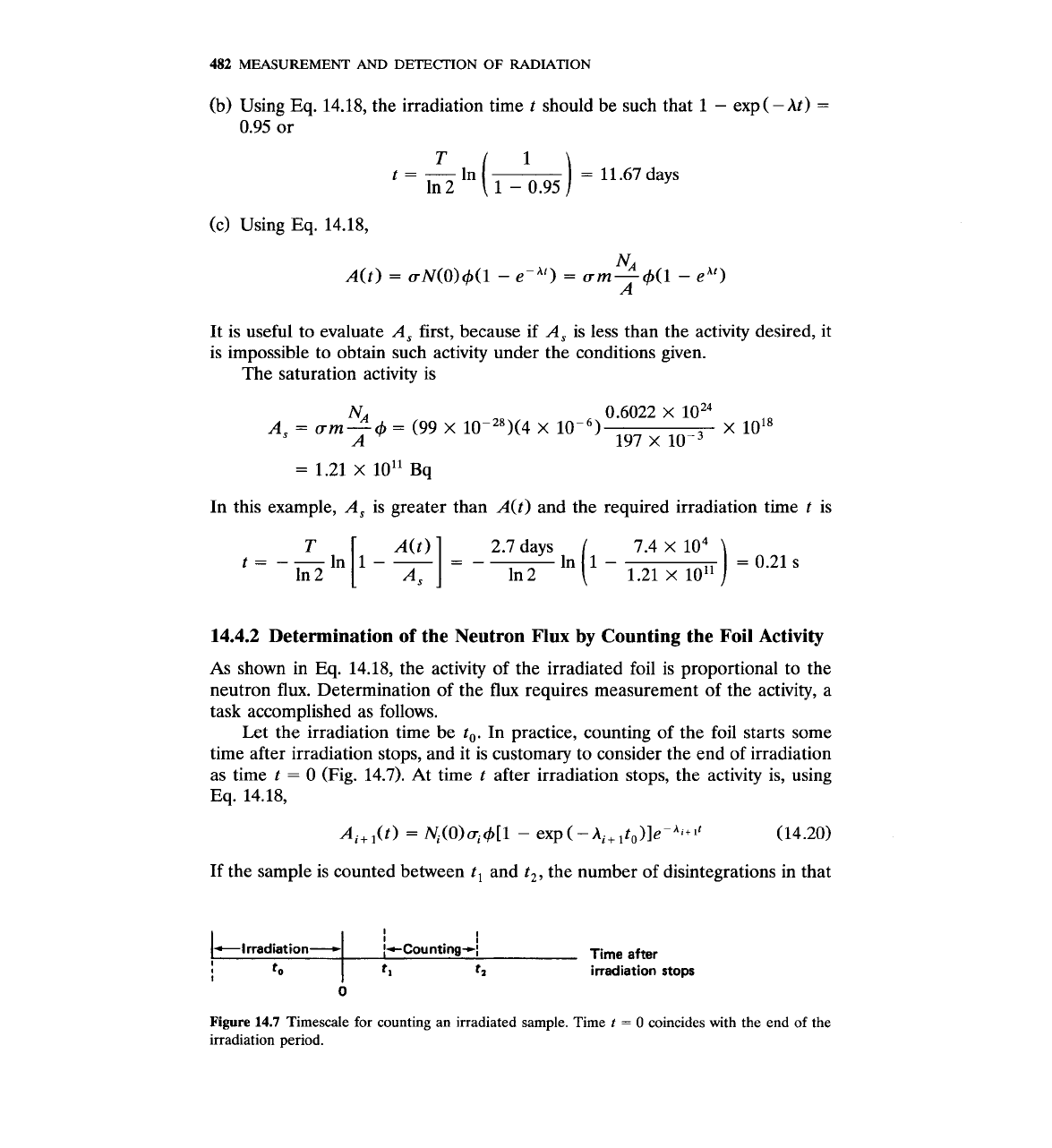
482
MEASUREMENT
AND
DETECTION
OF
RADIATION
(b) Using Eq. 14.18, the irradiation time t should be such that
1
-
exp
(-
At)
=
0.95 or
(c) Using Eq. 14.18,
It is useful to evaluate A, first, because if A, is less than the activity desired, it
is impossible to obtain such activity under the conditions given.
The saturation activity is
In this example, A, is greater than
A(t) and the required irradiation time t is
T
A(t) 2.7 days
n
I--
=--
1-1 In 2
[
As]
In 2
In
(I
-
1.21
x
10"
14.4.2
Determination of the Neutron Flux
by
Counting the Foil Activity
As
shown in Eq. 14.18, the activity of the irradiated foil is proportional to the
neutron
flux.
Determination of the
flux
requires measurement of the activity, a
task accomplished as follows.
Let the irradiation time be
to.
In practice, counting of the foil starts some
time after irradiation stops, and it is customary to consider the end of irradiation
as time
t
=
0 (Fig. 14.7). At time t after irradiation stops, the activity is, using
Eq. 14.18,
Ai+ I(t)
=
N,(0)ui+[l
-
exp
(
-A~+
lto)leh+l' (14.20)
If the sample is counted between t, and t,, the number of disintegrations in that
Figure
14.7
Timescale for counting an irradiated sample. Time
t
=
0
coincides with the end of the
irradiation period.
-Irradiation-
to
I
I
;--counting+; Time after
t
I
t2
irradiation stops
0
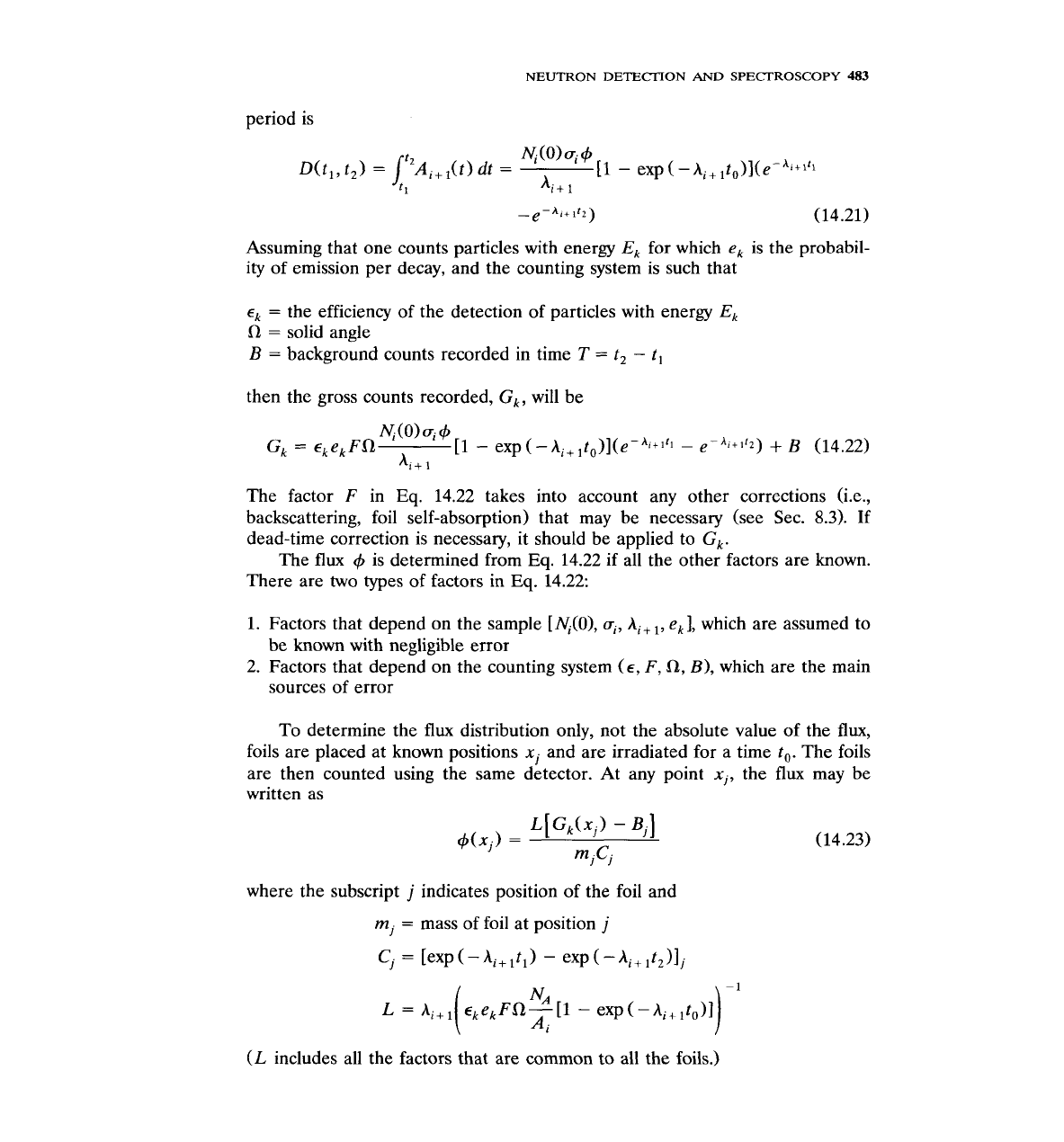
NEUTRON
DETECTION
AND
SPECTROSCOPY
483
period is
Assuming that one counts particles with energy
Ek
for which
ek
is the probabil-
ity of emission per decay, and the counting system is such that
E,
=
the efficiency of the detection of particles with energy
E,
R
=
solid angle
B
=
background counts recorded in time
T
=
t,
-
t,
then the gross counts recorded, G,, will be
The factor
F
in
Eq.
14.22 takes into account any other corrections (i.e.,
backscattering, foil self-absorption) that may be necessary (see Sec. 8.3). If
dead-time correction is necessary, it should be applied to
G,.
The
flux
+
is determined from
Eq.
14.22 if all the other factors are known.
There are two types of factors in
Eq.
14.22:
1. Factors that depend on the sample
[N,(O),
a,,
hi+
,,
e,], which are assumed to
be known with negligible error
2. Factors that depend on the counting system
(E,
F,
a,
B),
which are the main
sources of error
To determine the
flux
distribution only, not the absolute value of the
flux,
foils are placed at known positions
x,
and are irradiated for a time
to.
The foils
are then counted using the same detector. At any point
x,,
the
flux
may be
written as
where the subscript
j
indicates position of the foil and
m,
=
mass of foil at position
j
(L
includes all the factors that are common to all the foils.)
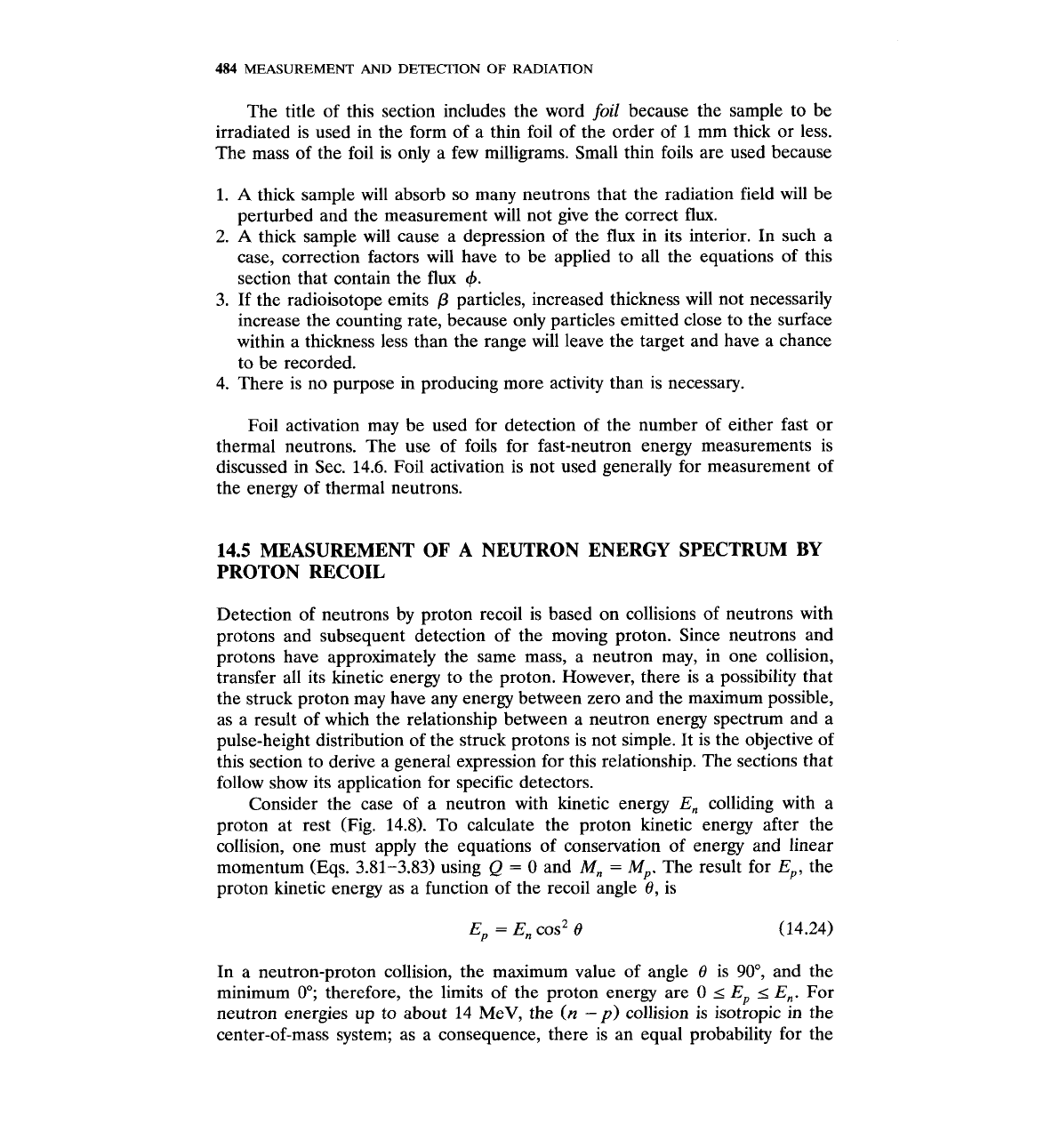
484
MEASUREMENT
AND
DETECTION
OF
RADIATION
The title of this section includes the word
foil
because the sample to be
irradiated is used in the form of a thin foil of the order of
1
mm thick or less.
The mass of the foil is only a few milligrams. Small thin foils are used because
1.
A
thick sample will absorb so many neutrons that the radiation field will be
perturbed and the measurement will not give the correct
flux.
2.
A
thick sample will cause a depression of the
flux
in its interior. In such a
case, correction factors will have to be applied to all the equations of this
section that contain the
flux
4.
3.
If the radioisotope emits
P
particles, increased thickness will not necessarily
increase the counting rate, because only particles emitted close to the surface
within a thickness less than the range will leave the target and have a chance
to be recorded.
4. There is no purpose in producing more activity than is necessary.
Foil activation may be used for detection of the number of either fast or
thermal neutrons. The use of foils for fast-neutron energy measurements is
discussed in Sec. 14.6. Foil activation is not used generally for measurement of
the energy of thermal neutrons.
14.5
MEASUREMENT OF A NEUTRON ENERGY SPECTRUM
BY
PROTON RECOIL
Detection of neutrons by proton recoil is based on collisions of neutrons with
protons and subsequent detection of the moving proton. Since neutrons and
protons have approximately the same mass, a neutron may, in one collision,
transfer all its kinetic energy to the proton. However, there is a possibility that
the struck proton may have any energy between zero and the maximum possible,
as a result of which the relationship between a neutron energy spectrum and a
pulse-height distribution of the struck protons is not simple. It is the objective of
this section to derive a general expression for this relationship. The sections that
follow show its application for specific detectors.
Consider the case of a neutron with kinetic energy
En
colliding with a
proton at rest (Fig. 14.8). To calculate the proton kinetic energy after the
collision, one must apply the equations of conservation of energy and linear
momentum
(Eqs. 3.81-3.83) using
Q
=
0 and
Mn
=
Mp.
The result for
E,,
the
proton kinetic energy as a function of the recoil angle
8,
is
In a neutron-proton collision, the maximum value of angle
0
is 90°, and the
minimum 0"; therefore, the limits of the proton energy are
0
I
Ep
I
En.
For
neutron energies up to about 14 MeV, the
(n
-p)
collision is isotropic in the
center-of-mass system; as a consequence, there is an equal probability for the

NEUTRON DETECTION
AND
SPECTROSCOPY
485
I
I
I
Neutron
!
Figure
14.8
Neutron-proton collision
Before collision
I
After collision
kinematics.
I
proton to have any energy between zero and
En
in the laboratory system. That
is, if p(E) dE is the probability that the proton energy is between
E
and
E
+
dE, after the collision, then
The function p(E) is shown in Fig.
14.9.
What is important for the observer is
not p(E) but the proton pulse-height distribution produced by the detector. The
relationship between the pulse-height distribution and the neutron spectrum is
derived as follows. Let
4(
En) dEn
=
neutron energy spectrum
=flux
of neutrons with energy
between
En
and En
+
dEn
N(
Ep) dEp
=
proton recoil energy spectrum
=
number of protons produced (by
collisions with neutrons) with energy between
Ep
and
Ep
+
dE,
R(
E, Ep) dE
=
response function of the detector
=
probability that a proton
of energy
Ep
will be recorded as having energy between E and
E
+
dE
(defined before in Sec.
11.5)
M(E) dE
=
measured spectrum
=
number of protons measured with energy
between
E
and E
+
dE
The measured spectrum M(E) is the pulse-height distribution in energy
scale. The response function
R(E, Ep) takes into account the finite energy
Figure
14.9
The proton energy distribu-
tion after a
(n,p)
collision that
is
isotropic in the center of mass system of
En
E
the two particles.
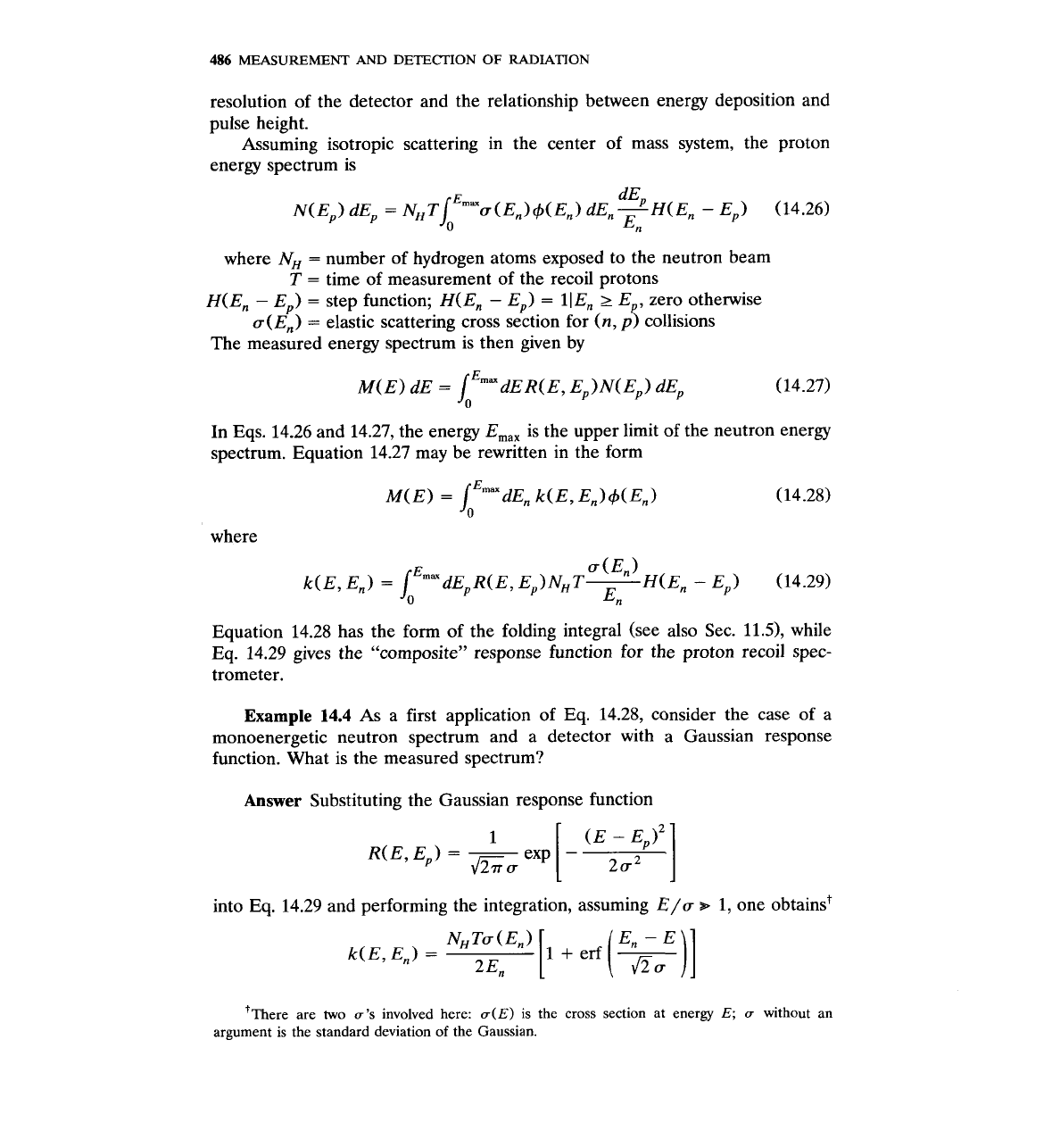
486
MEASUREMENT
AND
DETECTION
OF
RADIATION
resolution of the detector and the relationship between energy deposition and
pulse height.
Assuming isotropic scattering in the center of mass system, the proton
energy spectrum is
where
N,
=
number of hydrogen atoms exposed to the neutron beam
T
=
time of measurement of the recoil protons
H(En
-
E,)
=
step function; H(En
-
E,)
=
lIEn
r
E
,
zero otherwise
u(En)
=
elastic scattering cross section for
(n,
p?
collisions
The measured energy spectrum is then given by
In Eqs. 14.26 and 14.27, the energy
Em,,
is the upper limit of the neutron energy
spectrum. Equation 14.27 may be rewritten in the form
where
Equation 14.28 has the form of the folding integral (see also
Sec. 11.51, while
Eq. 14.29 gives the "composite" response function for the proton recoil spec-
trometer.
Example
14.4
As a first application of Eq. 14.28, consider the case of a
monoenergetic neutron spectrum and a detector with a Gaussian response
function. What is the measured spectrum?
Answer
Substituting the Gaussian response function
into Eq. 14.29 and performing the integration, assuming E/u
*
1, one obtainst
h here
are two a's involved here: u(E) is the cross section at energy
E;
u
without an
argument is the standard deviation of the Gaussian.
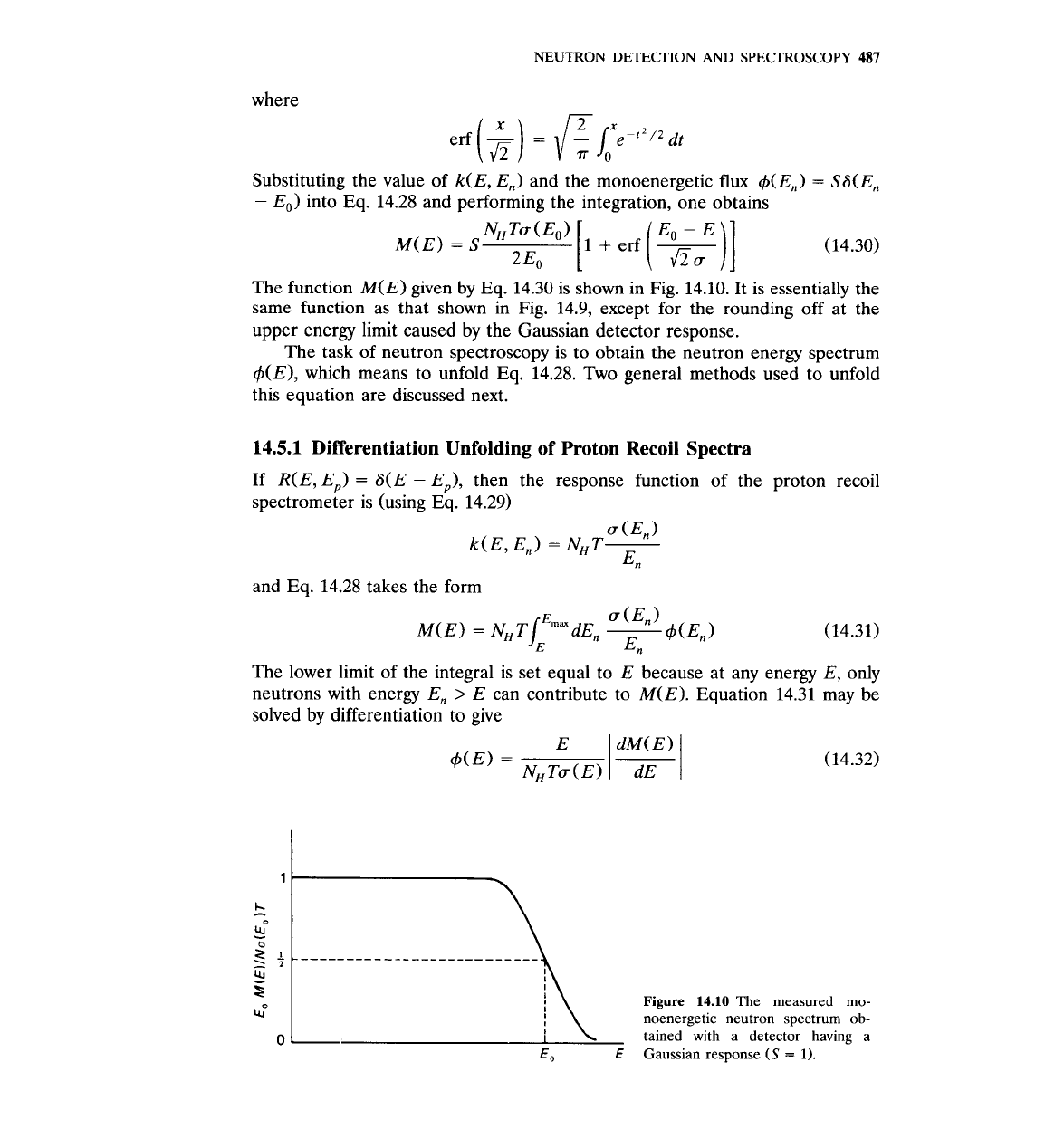
NEUTRON
DETECTION
AND
SPECTROSCOPY
487
where
Substituting the value of k(E, En) and the monoenergetic
flux
+(En)
=
S6(En
-
E,) into Eq. 14.28 and performing the integration, one obtains
The function
M(E)
given by
Eq.
14.30 is shown in Fig. 14.10. It is essentially the
same function as that shown in Fig. 14.9, except for the rounding off at the
upper energy limit caused by the Gaussian detector response.
The task of neutron spectroscopy is to obtain the neutron energy spectrum
4(E), which means to unfold Eq. 14.28. Two general methods used to unfold
this equation are discussed next.
14.5.1
Differentiation Unfolding of Proton Recoil Spectra
If R(E,
EJ
=
6(E
-
EJ then the response function of the proton recoil
spectrometer is (using Eq. 14.29)
and Eq. 14.28 takes the form
The lower limit of the integral is set equal to E because at any energy E, only
neutrons with energy En
>
E can contribute to M(E). Equation 14.31 may be
solved by differentiation to give
Figure
14.10
The measured mo-
noenergetic neutron spectrum
ob-
tained with a detector having a
E
o
E
Gaussian response
(S
=
1).
